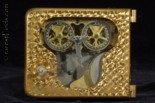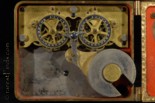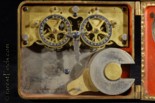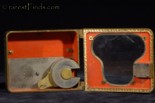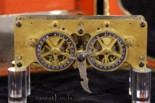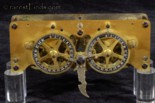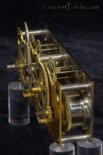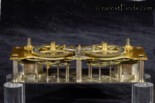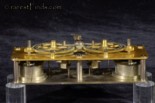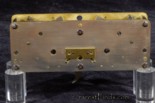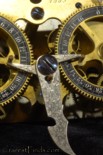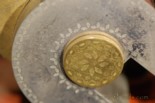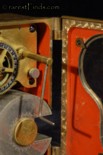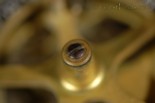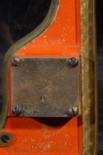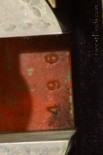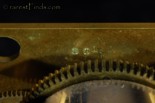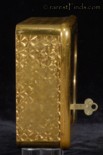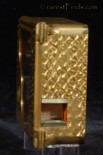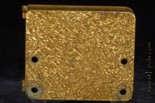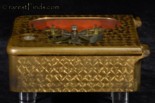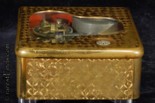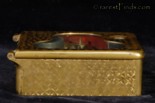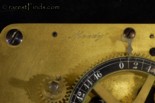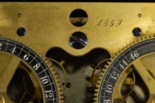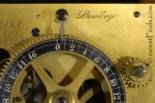Only three other Safe Time Looks like this are known to have survived! [1] page 152. Sold!
Patents, click on any image to see larger image!
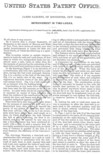

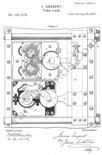

This antique Sargent & Greenleaf Safe-Time-Lock (STL) is a model 2.4 according to [1] p. 152, and only three other STLs like this one are known to have survieved. According to [1], between 150 and 200 STLs of the model 2.4 were made in 1876 and into the beginning of 1877. [1] refers to the wonderful book “American Genius, Nineteenth-Century Bank Locks and Time Locks, by John Erroll & David Erroll”, published in 2006. The photography is outstanding, the research and descriptions of STL’s meticulous; the book is one of my favorit books (and I have a lot of books!) You can buy one on Amazon or AbeBooks for as little as $25.
Sargent & Greenleaf introduced his first Safe-Time-Lock in 1874. The first Safe-Time-Lock sold on June 11, 1874. Only two of the model 1 survived, ([1] p.148). Sargent & Greenleaf made its own clockwerk movements unlike other manufacturers of Safe-Time-Locks. The model 2.1 followed with a power reserve of 46 hours but with wheels showing time up to 48 hours. The model 2.1 was replaced after a short life with model 2.2. Only one example of the model 2.1 survived, it is the one with the serial number 66.
Sargent & Greenleaf’s earliest patent application dates to July 12, 1875 and was promptly issued eight days later on July 20, 1875 with the number 165,878 (see pictrues above.) Unlike other STL makers, the early Sargent & Greenleaf STLs have a gravity-operated Bolt.
Model 2.3 is recognized as having as an improvement “the fixed-arbor dials with dials attached at the front by a screw and washer assembly, making accurate servicing easier”, [1] p. 152. See picture 14 above. There are four examples known to have survived of the model 2.3.
The model offered here is a model 2.4; about 150 to 200 were made in 1876 and into the beginning of 1877. Three Safe-Time-Locks of this antique model were known to exist before the lock offered here was discovered. The STL offered here has the serial number 496 stamped into the case in two places, obove the lock as shown in picture #15, underneath the rollerbolt as shown in picture #16, and on the back of the back-plate.
The model 2.3 had rough leaf-and-vine engraving on the movement’s front plate which is no longer present on the model 2.4. The number 391 is stamped into the back of the front plate, see picture # 17. According to [1], “added engraved nickel-plating to the rollerbolt was applied”. The nickel-plating on the STL offered here differs. The model 2.4 pictured in [1] p.154 shows not only the rollerbolt nickel plated, all the members beneath the movements are nickel-plated; the hook-lever, rollerbolt-tail, rollerbolt, spindle, and back-plate, everything is nickel-plated.
The model 2.4 offered here shows a more interesting scheme; the hook-lever is nickel-plated, the rollerbolt-tail is gold-plated, the rollerbolt is nickel-plated, the spindel gold-plated, and the back-plate nickel-plated. In this authors opinion, a much more visually attractive finish.
The model 2.5 followed whith hinges inside the case; none of the model 2.5 STLs is known to have survived. The model 2.6 featured a redisigned rollerbolt refered to as cello-bolt due to its shape as a cello.
Sargent & Greenleaf’s price for one of the model 2 STL was a hefty $400; more than $9,000 in today’s value of the US$. The safe itself was often less expensive than the STL.
This STL is rather large and heavy; the case measures 8.25 by 6.5 by 2.75 inches and weighs 17.1 lb. The STL still retains his windup key (see pictrure #13) and a key for the door-lock (not original to the lock).
The ownership history of STLs is usually unknown. The antique Safe-Time-Lock offred here has an engraving revealing its provenance! This STL is engraved with the two names Moody and Sankey and the year 1869, see pictures 24-26.
Moody & Sankey were the rockstars of their time. Unlike today, when we do no longer have funcitonal institutions like church, family, commuity, government, judiciary and others, to Moody & Sankey’s time, the church was all present and functioning as the backbone of morality and society.
Evangelists Moody & Sankey traveled the world spreding the word of god; Moody by preaching, and Sankey by singing gospell and hymns. Ira David Sankey wrote and composed the hymns and Moody had them printed. Millions of their booklets sold and made them both wealthy. Both men were philantropists and made huge donations to build churches and other gathering places.
The engraved year 1869 comemorates the start of the partnership between Moody & Sankey; the year has nothing to do with the STL as the model 2.4 was not being manufactured untill 1876. The year 1876 was when Moody & Sankey were at the top of their game and it is not surpricing that they owned a safe to keep their money safe.
According to history, Moody, as a delegate of the Young Men’s Christian Association (YMCA) from Chicago, encountered Sankey for the first time when Sankey was allegedly sent as a delegate of the YMCA from New Castle, Pennsylvania to the international convention of the YMCA at Indianapolis in 1870.
On hearing Ira Sankey sing, at once invited him to come to Chicago, and assist him in his evangelical work there, which offer, after some deliberation, he decided to accept, and six months after their first interview he resigned his position and joined Mr. Moody in Chicago. As so often, researchers copy gospel from each other. The year 1870 seems to be cut in stone; is it possible that the partnership actually began in 1869? Or, did they not remember the year right when ordering the unusual engraving to their STL? By any measure, the discrepancy is an interesting one.
Condition:
This STL is in “as found” condition, no attempts have been made to clean it. Both movements surprisingly work but need cleaning. There is no rust on steel parts and I can't see any defects or missing parts. I noticed two springs which suppose to push two little levers onto the teeth of the two spring housings. However, the two springs are bent out of place and are not touching the little levers, see picture #9.
History:
Dwight Lyman Moody (February 5, 1837 – December 26, 1899), also known as D. L. Moody, was an American evangelist and publisher connected with Keswickianism, who founded the Moody Church, Northfield School and Mount Hermon School in Massachusetts (now Northfield Mount Hermon School), Moody Bible Institute and Moody Publishers.] One of his most famous quotes was "Faith makes all things possible... Love makes all things easy." Moody gave up his lucrative boot and shoe business to devote his life to revivalism, working first in the Civil War with Union troops through YMCA in the United States Christian Commission. In Chicago, he built one of the major evangelical centers in the nation, which is still active. Working with singer Ira Sankey, he toured the country and the British Isles, drawing large crowds with a dynamic speaking style.
Ira David Sankey (August 28, 1840 – August 13, 1908) was an American gospel singer and composer, known for his long association with Dwight L. Moody in a series of religious revival campaigns in America and Britain during the closing decades of the 19th century. Sankey was a pioneer in the introduction of a musical style that influenced church services and evangelical campaigns for generations, and the hymns that he wrote or popularized continued to be sung well into the 21st century.
Sankey, born in Pennsylvania, was an amateur singer and church worker when he was recruited by Moody in 1870 (or 1869?), after the latter heard him sing at a convention. Until Moody’s death in 1899 the two campaigned together, Moody preaching while Sankey sang both old and new hymns, inspired by writers such as Fanny Crosby and Philip Bliss. Sankey also became a prolific composer of hymn tunes, and a compiler and editor of popular hymn collections, in particular Sacred Songs and Solos and Gospel Hymns and Sacred Songs. The proceeds from these publishing ventures were used for a range of charitable purposes.
Moody & Sankey made tow trips to England, in 1873, and again in 1875. The picture on the left shows Moody & Sankey on board of the ocean liner Spain at their departure to the United States.
While Moody & Sankey were in London, publisher R. C. Morgan offered to publish a collection of the songs used in the meetings. “So,” Sankey recalled, “I cut from my scrap-book twenty-three pieces, rolled them up, and wrote on them the words ‘Sacred Songs and Solos, sung by Ira D. Sankey at the meetings of Mr. Moody of Chicago.’”
This was the beginning of one of the most successful publishing ventures in the history of hymnody. With each new edition, Sankey added more hymns. During Sankey’s lifetime, an estimated 75 million copies were sold.
England 1873 and 1875
While Moody & Sankey were in London, publisher R. C. Morgan offered to publish a collection of the songs used in the meetings. “So,” Sankey recalled, “I cut from my scrap-book twenty-three pieces, rolled them up, and wrote on them the words ‘Sacred Songs and Solos, sung by Ira D. Sankey at the meetings of Mr. Moody of Chicago.’”
This was the beginning of one of the most successful publishing ventures in the history of hymnody. With each new edition, Sankey added more hymns. During Sankey’s lifetime, an estimated 75 million copies were sold.
Picture on the right depicts Dwight Moody and Ira Sankey before a large audience inside John Wanamaker’s Grand Depot at 13th & Market Streets. A large banner bearing a biblical quotation hangs on the wall behind the preachers.
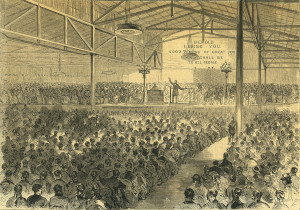 In 1876 John Wanamaker purchased the abandoned Pennsylvania Railroad Station for his Grand Depot. Prior to its opening as a retail business the same year, Wanamaker allowed the evangelists use of the building as a meeting place. (Click on picture to download large image.)
In 1876 John Wanamaker purchased the abandoned Pennsylvania Railroad Station for his Grand Depot. Prior to its opening as a retail business the same year, Wanamaker allowed the evangelists use of the building as a meeting place. (Click on picture to download large image.)
George H. Stuart reported in the New York Tribune on January 14, 1876:
“The last service of the eighth week of Moody and Sankey’s labors in this city was attended this evening by over thirteen thousand persons, filling the great depot building to its utmost capacity. Many thousands were turned away, unable to obtain even >standing room. The interest in these services has from the first steadily increased, and the labors of the evangelists have been and continue to be the all absorbing topic of conversation.”
After Moody’s death, Sankey attempted to carry on the work alone, but was defeated by ill-health and the eventual loss of his eyesight. He died in 1908. He was inducted into the Gospel Music Hall of Fame in 1980.
Literature:
(Click on any title to see the online version of the book if there is one.)
[1]
American Genius, Nineteenth-Century Bank Locks and Time Locks, by John Erroll & David Erroll, (2006)
Inventory Number 09346;
Sold!
This writer found this interesting and moving story on the web about Sankey:
It was Christmas Eve 1876 and Ira D. Sankey, the famous singer and songwriter, was traveling on a steamboat up the Delaware River. Travelers on such a holiday, seemingly cut adrift in a world where everyone else is celebrating with loved ones, often seem to cling together making a circle of warmth in a waiting room, in a plane or in an almost deserted restaurant.
This was such a journey. On the deck were gathered a number of passengers, looking out at the calm, starlit night. Someone said, “Mr. Sankey is aboard!” and immediately there were cries of “Let him sing for us! Let’s ask Mr. Sankey to sing!”
He was leaning against one of the great funnels of the boat. Before he began, he stood for a moment as if in prayer, deciding what to sing. He wanted to sing a Christmas song, but somehow the words of the shepherd song were what came to his heart.
Much we need Thy tender care
In Thy pleasant pastures feed us
For our use Thy folds prepare”
“Blessed Jesus, blessed Jesus
Thou hast bought us, Thine we are
Blessed Jesus, blessed Jesus
Thou hast bought us, Thine we are”
There was a deep stillness throughout the crowd. The words, telling the sweet story of God’s love for wandering men, and the beautiful melody floated out across the deck, across the water and into the night. Every heart was stirred.
At the end of the song, a rough-looking man stepped forward. To Sankey, he asked, “Did you ever serve in the Union Army?” “Yes,” answered Sankey. “Can you remember if you were doing picket duty on a bright moonlight night in 1862?” “Yes, I do,” answered Sankey, with surprise. “Were you...?”
“I did, too, but I was serving in the Confederate Army. When I saw you standing at your post, I said to myself, ‘that fellow will never get away from here alive.’ I was in the shadow, completely hidden, while you walked in full moonlight.”
“I raised my rifle and took aim. At that instant, you began to sing, just like a moment ago. The song was ‘Saviour, like a shepherd lead us...’”
“The music touched my heart and I took my finger off the trigger. ‘I’ll wait until the end of the song,’ I said to myself. ‘I can’t miss him, and I can shoot him afterwards.’”
Be the Guardian of our way
Keep Thy flock, from sin defend us
Seek us when we go astray”
“Blessed Jesus, blessed Jesus
Hear, O hear us when we pray
Blessed Jesus, blessed Jesus
Hear, O hear us when we pray”
“As you sang, you reached the place where it says, ‘We are thine, do thou befriend us, be the guardian of our way...’ ”
“I could hear every word perfectly, and how the memories came to my heart! I began to think of my childhood and my mother. She loved God and had sung that song to me many times. But she died all too soon, otherwise I think my life might have been different.”
“At the end of the song, I found it impossible for me to take aim, though you still stood in the bright moonlight, a perfect target.”
“Then I thought of the Lord. I looked at you and thought, ‘the Lord who was able to save that man from certain death must surely be great and mighty.’ My arm dropped to my side and I cannot tell you all the things I thought at that time. My heart was smitten, but I didn’t know what to do.”
“Just now, when you were about to sing and stood quietly as if praying, I recognized you. I’ve wandered far and wide, since that other occasion. I have never found that Shepherd. Please help me now find a cure for my sick soul.”
Deeply moved, Sankey threw his arms about the man who had been his enemy. A man who could have ended his life. That Christmas Eve night, a former soldier found the great and tender Shepherd as his Saviour.
